What Is a Public Safety Drone?
The Best Public Safety Drones of 2024, 54 Uses Cases for Drones in Public Safety, and More
Public safety drones are any drone used to support the work of first responders.
While there are a handful of drones made specifically for work in public safety, the term can apply generally to describe whatever drone a public safety agency has chosen to use in its work, regardless of how the drone is marketed or the original use cases its manufacturer may have imagined for it.
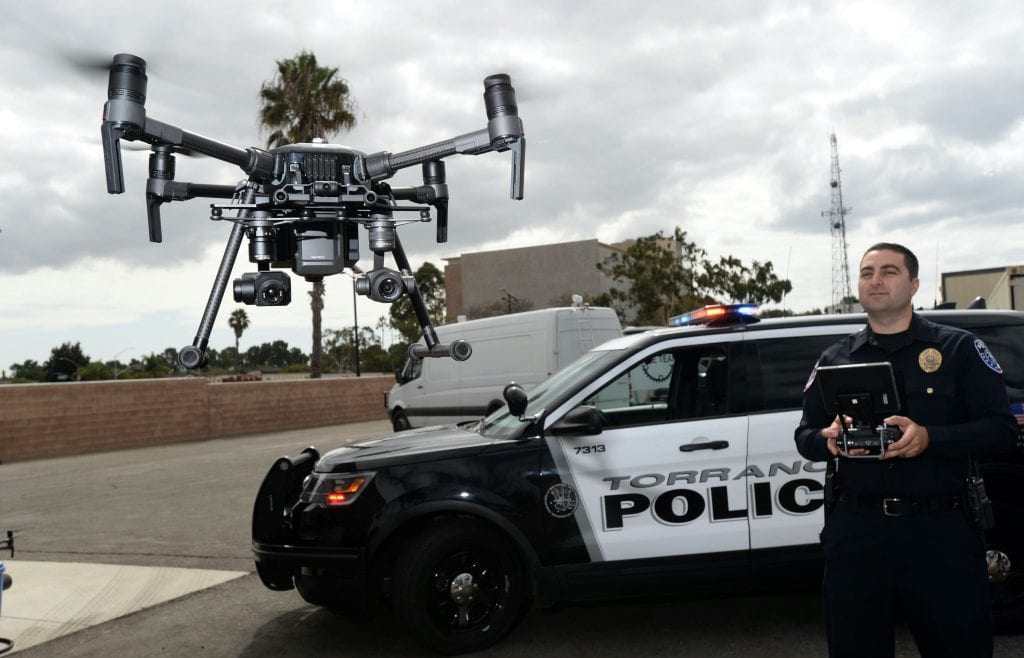
Credit: Torrance Police Department / Axel Koester
In the last ten years, the use of drones to support public safety work has gone from an interesting concept to a tried and tested reality. This fact is demonstrated in the phrase itself—a decade ago, the term “public safety drone” hadn’t yet entered our general vocabulary.
Now, public safety drones are commonplace. In any major city you’ll find drones supporting the work of police departments, fire departments, search and rescue teams, and disaster management personnel.
It’s also now common knowledge that you’ll probably need several types of drones to support public safety work, especially if you’re a larger organization. While some drones are good for their autonomy and suited for quickly searching an area for victims after a crash, other drones are good for collecting LiDAR data in rugged environments to support the creation of detailed 3D maps for disaster planning or risk mitigation.
If you’re just getting started in your public safety drone journey, this in-depth guide is for you. In the guide we cover the best public safety drones on the market, the ways that different types of public safety agencies are using drones in their work, legal considerations for adopting public safety drones, and more.
Here’s a table of contents in case you’d like to jump around:
- Best Public Safety Drones of 2023
- How to Use Drones in Public Safety
- Legal Considerations—Choosing Between the Part 107 or the COA
- Drone As First Responder (DFR) Programs
- 54 Public Safety Drone Use Cases
Want to Start a Drone Program in Your Police or Fire Department?
Here are some resources to help you get started:
- Applying for a Public COA vs. Part 107 Certification for Police and Fire Departments
- A Drone Pilot’s Guide to Tactical BVLOS (TBVLOS) Waivers for Public Safety Agencies
- Drone as a First Responder: A Guide to DFR Programs and First Responder Drones
- Master List of Drone Laws (Organized by State)
- Drone License: A Step-by-Step Guide to FAA Part 107 Certification for U.S. Commercial Drone Pilots
This article is part of a series on drones in public safety. Here are the other articles in the series:
- Police Drones: A Guide to How Law Enforcement Uses Drones in Its Work
- Firefighting Drones: A Guide to How Fire Departments Uses Drones in Their Work
- Search and Rescue Drones: A Guide to How SAR Teams Use Drones in Their Work
- Drone as a First Responder: A Guide to DFR Programs and First Responder Drones
Best Public Safety Drones [New for 2024]
1. Skydio X2
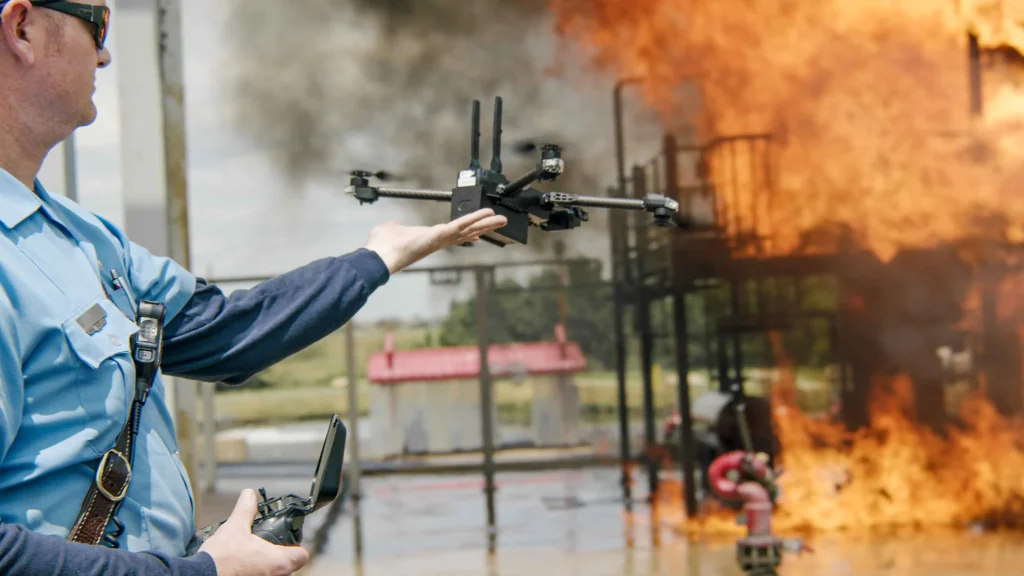
Credit: Skydio
The Skydio X2 is a portable and ruggedized drone equipped for both day and night operations. Skydio is best known for its autonomy—a feature that lets the drone basically fly itself, allowing the pilot to pursue a suspect on foot, or gain situational awareness while focused on what’s happening in an unfolding situation.
Features and Specs:
- Flight time. 35 minutes.
- Camera. 4K60P HDR color camera with 16x digital zoom and ~46° HFOV, FLIR® Boson 320 x 256 infrared camera with 8x digital zoom and ~80° HFOV.
- Autonomy. Skydio autonomy with 360° obstacle avoidance using six 4k 200° navigation cameras and onboard AI running on NVIDIA TX2.
- Night operations. GPS flight and strobe lighting.
- Transmission range. 3.7 miles / 6km (5GHz)* or 6.2 miles / 10km (1.8GHz).
- Security and supply chain. NDAA compliant.
- Portability. Foldable arms, pinch-release antenna, can go from packed to airborne in under 75 seconds.
Learn more about the Skydio X2.
2. BRINC’s Lemur 2
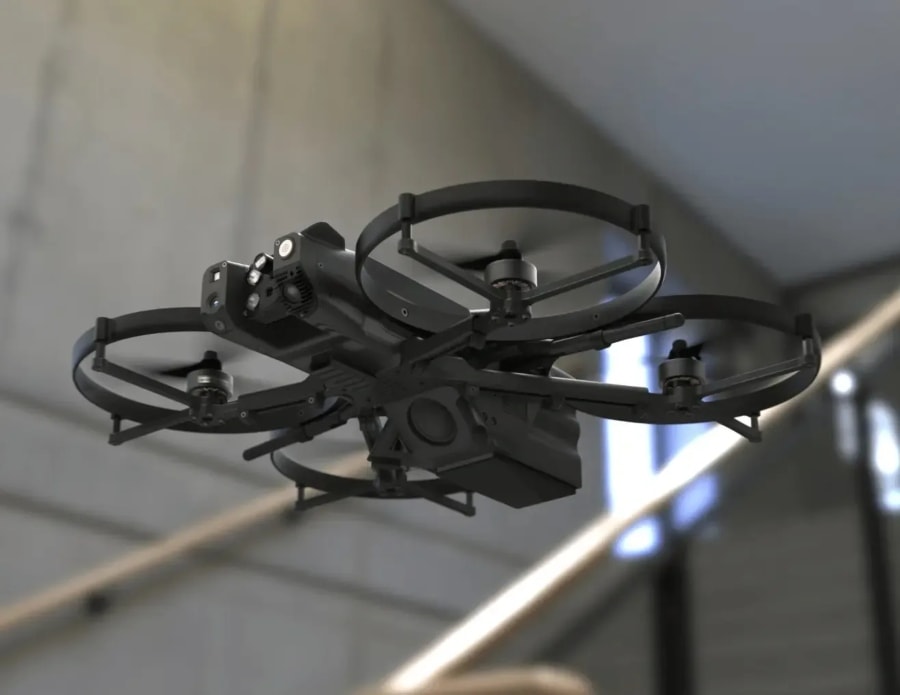
Credit: BRINC
The BRINC Lemur 2 is a public safety drone first, meaning it was designed specifically for work in public safety, with a focus on law enforcement and use in hostage / active shooter situations. The Lemur 2 has unique features that make it capable of navigating tight indoor spaces, providing two-way communication, and breaking through glass windows to enter buildings.
Features and Specs:
- Flight time. 31 minutes.
- Two-way communication. Allows law enforcement to negotiate with suspects during a hostage or active shooter situation and communicate with victims being held captive.
- Indoor flight. The Lemur 2 is designed to fly indoors, navigating the tight spaces found inside buildings where an active shooter could be present.
- Glass breaker. The Lemur 2 features a blade attached solely for the purpose of breaking through windows to gain access to the interior of a building. As far as we know, it is the only drone with this capability.
- Night vision sensor. Allows the drone to operate in low-light conditions.
- Encrypted video signal. Ensures secure transmission of video data.
3. DJI Matrice 30

Credit: DJI
DJI’s Matrice series is widely used by law enforcement and other public safety agencies. The Matrice 30 is the smallest model in the Matrice line, which is why it’s called the first “backpack drone” in the series. The M30 can be equipped with an optional thermal camera, and it’s a rugged, portable drone made to support work in the field, including public safety work.
Features and Specs:
- Flight time. 41 minutes with the self-heating TB30 battery.
- Camera. 48MP 1/2″ CMOS zoom camera; 5x-16x optical zoom and 200x digital zoom; 8K photo 4K/30fps video resolution.
- Laser rangefinder. Provides precise position information of objects up to .75 miles / 1.2 km away.
- Thermal camera (M30T only). 640×512 radiometric thermal camera, essential for low-light public safety operations.
- Weather resistance. IP55 ingress protection; operable in temperatures ranging from -4°F to 122°F.
- Portability. Foldable, lightweight (8 pound take-off weight), and highly portable.
- Safety features. Low-light first-person pilot camera; built-in redundancy and backup processes; three-propeller emergency landing system; Health Management System; and six-way collision avoidance sensors.
Learn more about the Matrice 30.
4. DJI Matrice 300 RTK

Credit: DJI
The Matrice 300 RTK is a larger, slightly older model in the Matrice line. The M300 is a solid public safety drone for entities who want to do 3D mapping, since the RTK system enables high-accuracy mapping for precise data collection, making it ideal for detailed 2D and 3D mapping of crime scenes or traffic accidents. It’s also good for longer-range missions, like those over active wildfires or in search of missing persons.
Features and Specs:
- Flight time. 55 minutes.
- Camera (H20T). 20MP Zoom (200x max. zoom & 4K video), 12MP Wide lens, 640×512 resolution thermal camera.
- Speed. Up to 51 mph.
- Weather resistance. IP45 weather sealing rating.
- Payload capacity. Up to three payloads can be mounted simultaneously.
- Transmission range. Triple-channel 1080p 30fps video transmission up to 9.3 miles / 15 km.
- Data security. AES-256 encryption.
- Safety features. Anti-collision beacon; obstacle detection sensors; ADS-B receiver.
Learn more about the Matrice 300 RTK.
5. DJI Mavic 3T
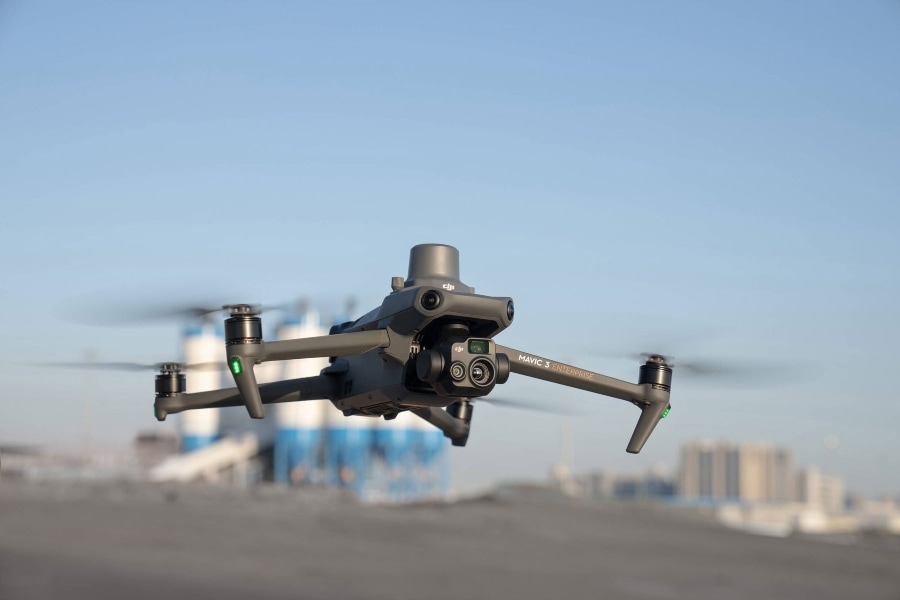
Credit: DJI
The DJI Mavic 3T is a version of the Mavic 3 Enterprise that comes equipped with a thermal camera. It offers a combination of advanced features that make it a powerful tool for public safety applications, including extended flight time and advanced safety features. It also has robust data protection measures, including a local data mode to prevent data transmission over the internet and AES-256 bit encryption for data transmission.
Features and Specs:
- Flight time. 45 minutes.
- Cameras. Dual visual and thermal cameras, 48 MP sensor for visual camera, 640 x 512 px radiometric data for thermal imaging.
- RTK module. Accessory port for optional RTK module.
- Transmission range. O3 Enterprise transmission system, maximum control distance of 9 miles / 15 km, 1080p 30fps high frame rate live broadcasting.
- Safety features. Wide-angle vision sensors on all sides; adjustable braking distances; proximity warnings; APAS 5.0; advanced RTH function.
- Data protection. Local data mode; option to remove all collected data; AES-256 bit encryption for data transmission.
What to Look for in a Public Safety Drone
For a drone to be useful for public safety applications it should come with certain key features.
Here’s what to look for:
1. High-Resolution Camera(s)
- Visual camera. Ensures clear and detailed images of scenes, aiding in situational awareness.
- Thermal imaging (if needed). Essential for nighttime operations and identifying heat signatures, especially useful in search and rescue missions.
2. Real-time Video Streaming
- Low latency. Minimized delays in video feed are crucial for timely decision-making.
- Encrypted signal. To prevent unauthorized access and ensure the privacy of operations.
- Extended transmission range (if needed). To support longer flights, such as those to support search and rescue missions or disaster relief.
3. Extended Flight Time
- Durable batteries. A longer flight time reduces the need for frequent landings and battery changes, ensuring continuous surveillance.
4. Safety
- 360° sensing and other obstacle avoidance features. Drones must safely navigate complex environments, especially in urban or disaster-stricken areas.
- Autonomy. Some degree of autonomy is a nice-to-have in order to ensure the drone can fly even if the pilot’s attention is divided by events unfolding on the ground.
- Return To Home (RTH). Safely guides the drone back to its launching point in case of a signal loss or low battery.
- Geo-fencing. Allows operators to set boundaries, ensuring the drone stays within a designated area.
5. Two-way Communication
- Loudspeakers (if needed). Allow for communication with ground teams or individuals, vital in hostage or active threat situations as well as for making announcements to crowds from a distance, but not necessary for many public safety operations.
6. Rugged Build
- Weatherproofing. The ability to operate in varied weather conditions, be it rain, wind, or extreme temperatures, is important to consider when choosing a public safety drone.
- Self-righting mechanisms. Sometimes called Turtle Mode, this can be useful for ensuring the drone can recover from potential collisions or crashes.
How to Use Drones in Public Safety
Just getting started with public safety drones? Here are some tips to help.
1. Choose the Right Drone(s)
Make sure to do your research and choose a drone, or drones, suitable for public safety operations.
The drones you choose should be equipped with essential features, which could include thermal imaging (if you’re doing firefighting work), real-time video streaming, GPS, and autonomous flight capabilities.
See the previous section for guidelines on choosing public safety drone hardware as well as our list of the best public safety drones on the market.
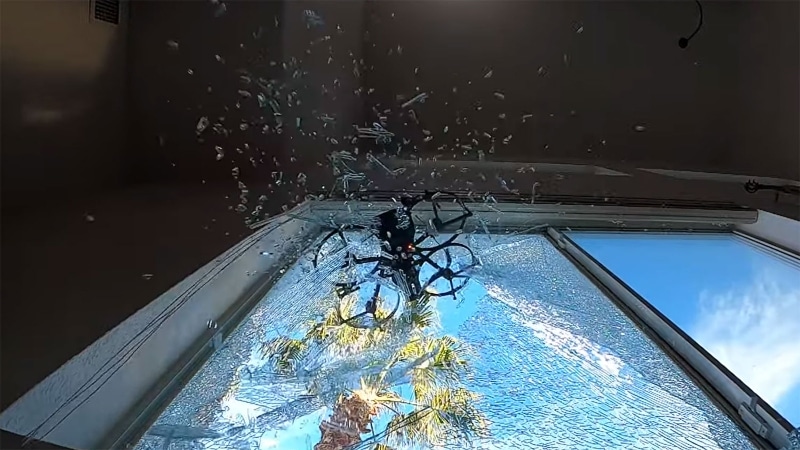
Credit: BRINC
2. Choose the Right Software
You may need software both for managing your drone operations and for creating 3D models (if you need them in your work).
There are software providers out there that specialize in supporting public safety work with drones. Axon, makers of the Taser, has a division called Axon Air that provides both drone hardware and drone software tailored for law enforcement.
And for 3D mapping or orthomosaics, there are software companies that specialize in making software just for drone operations.
Here are some resources to guide your software research:
- A Beginner’s Guide to Drone Mapping Software
- A Drone Pilot’s Guide to Flight Operations Management Tools
3. Get the Necessary Permissions to Operate
Before you start flying, make sure to obtain all necessary permissions and licenses from relevant authorities.
This will include:
- Part 107 vs. COA. Your public safety drone program can operate under either the FAA’s Part 107 rules, a COA (Certificate of Authorization (COA), or both. Jump down for a guide to help you navigate the choice.
- Waivers. If you get a COA you may be able to roll waiver requests into it. But either way, it’s important to do your research, and learn whether the areas where you’d like to operate, or the ways in which you’d like to operate (such as flying over people or beyond visual line of sight) require special waivers from the FAA.
- Airspace research. Research the airspace where you plan to fly, looking out for Temporary Flight Restrictions (TFRs) or other prohibitions that may be in place.
4. Train Your Drone Operators
Your drone pilots should be adequately trained and familiar with the capabilities of every drone you use, and know how to operate each one safely and proficiently.
Training considerations are important not just for one-off skill building but also for maintaining piloting skills.
When thinking about training, make sure to schedule refreshers so your pilots stay current on all your drone models. One way to do this is to have a minimum flight hour requirement per month or quarter, which could be assigned for each type of drone your agency owns.
5. Create Your Drone Program
In addition to training, you’ll want to put in the work to create a full fledged drone program. This includes:
- Creating SOPs for all of your operations.
- Defining how you store and manage your drone equipment (drone batteries are a little tricky, and will require some specialized knowledge).
- Documenting how you train your pilots + how many flight hours your pilots must log to stay current
- Acquiring your drones and any software you need to support their operation.
Here are some resources to help you get started:
- An Introductory Guide to Establishing a Professional Drone Program
- Drones in Fire Departments: The Step-by-Step Process the L.A. Fire Department Followed to Create Their Drone Program
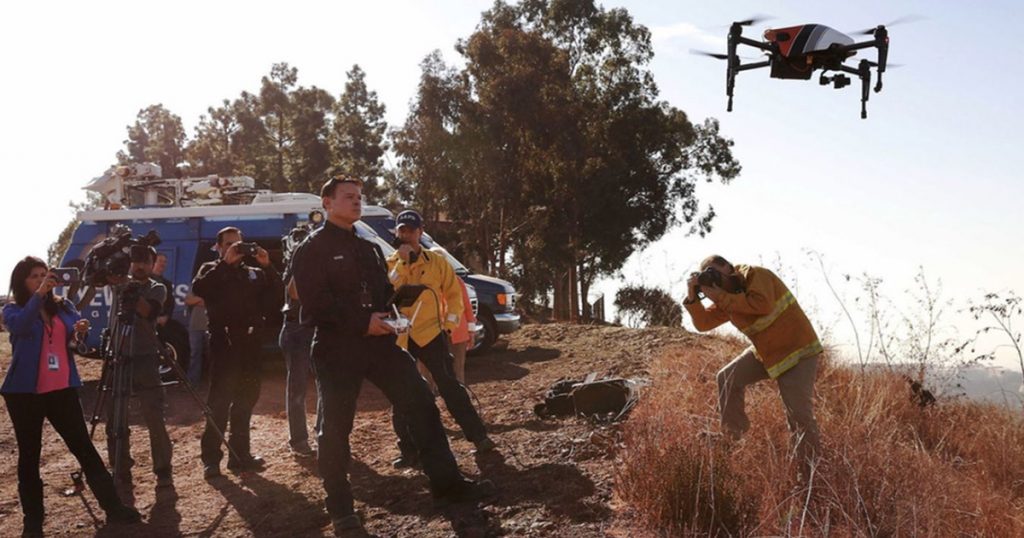
Credit: LAFD
How to Use Your Public Safety Drone
Once you’ve created your drone program, here’s a brief guide to planning and executing a drone operation in the field:
1. Plan the Operation
Carefully plan the operation by assessing the situation, defining the objectives, and determining the best approach.
For example, if you are using a drone for search and rescue, define the search area, identify potential hazards, and determine the best time to conduct the operation.
Of course, in public safety you may not have a lot of time for planning—sometimes you need aerial data right away. But even in emergencies, take a moment to think through the goals of the operation and what you plan to accomplish. Pre-planning will pay dividends in helping you achieve your goals for the mission.
2. Do Pre-flight Checks
Before launching the drone, conduct pre-flight checks to ensure that all systems are functioning correctly, the batteries are fully charged, and the drone is ready for operation.
3. Fly the Mission
Operate the drone according to plan, using it to get the data you need and then bringing it back down as soon as you have that data.
4. Analyze the Data
Analyze the data collected by the drone to extract valuable information. This may include reviewing the video footage, analyzing the thermal images, or creating maps of the affected area.
Analysis may happen as the drone flies, with the pilot and others looking at the live feed to make decisions on the spot.
5. Post-operation Assessment
After the operation, conduct an assessment to evaluate the success of the operation, identify areas for improvement, and document the lessons learned.
Legal Considerations—Choosing Between the Part 107 or the COA
One key decision for a public safety agency is whether to operate under the FAA’s Part 107 rules or a Certificate of Authorization (COA).
You can operate under just one, or both. Keep reading for more information about each.
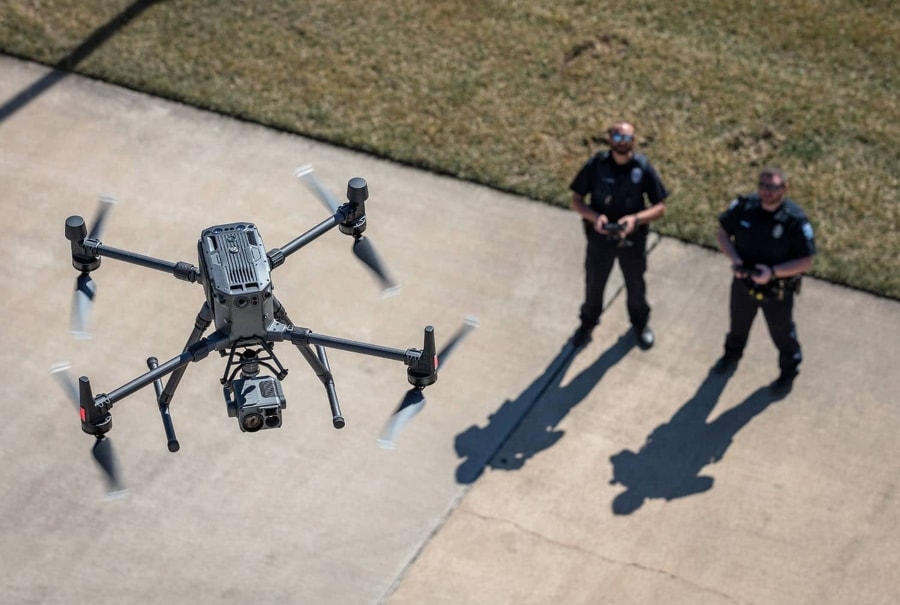
Part 107 for Public Safety Drone Programs
Part 107 is the FAA’s small UAS rule, which lays out all the rules for commercial drone operations in the U.S.
Operating under the Part 107 is often quicker to set up and has fewer restrictions, but it comes with certain limitations that might not be suitable for all public safety operations. For example, Part 107 does not allow operations beyond visual line of sight (BVLOS), over people, or at night without a waiver—activities you may want to unlock for your public safety work.
Additionally, each drone pilot on your team must have a Remote Pilot Certificate (commonly called a drone license) to fly under the Part 107 rules. (The biggest hurdle for getting the certificate is the FAA’s Part 107 test, also called the Aeronautical Knowledge Test.).
COAs for Public Safety Drone Programs
A Certificate of Authorization (COA) is an authorization issued by the FAA that allows public entities like law enforcement agencies, fire departments, and search and rescue teams to operate drones.
Operating under a COA can come with fewer restrictions than operating under the Part 107 rules, and can include permissions for BVLOS operations, operations over people, and night operations.
However, obtaining a COA can be a more complex and time-consuming process. Additionally, a COA often requires the public safety agency to have a comprehensive drone program, including trained operators, maintenance procedures, and operational guidelines.
Here’s some guidelines to help you choose:
1. Assess Your Needs
The first step in choosing between operating under the Part 107 rules or a COA is to assess the needs of your agency. Determine the types of operations you will be conducting, the locations you will be operating in, and any special requirements you may have, such as BVLOS operations or night operations, which might make a COA more appealing.
2. Consider the Limitations
Consider the limitations of Part 107 and the COA. If your agency can operate within the limitations of Part 107, it may be the quickest and easiest way to get started. However, if your operations require more flexibility, a COA may be necessary.
3. Evaluate Your Resources
Consider the resources available to your agency. Obtaining and operating under a COA may require more resources in terms of training, documentation, and operational procedures, as well as possible consulting fees if you seek the support of a third party to navigate the process.
4. Consult Legal and Regulatory Experts
It is always advisable to consult legal and regulatory experts to understand the implications of operating under Part 107 or a COA, and to ensure compliance with all legal requirements.
5. Consider Doing Both
Some public safety agencies decide to obtain Part 107 certification for their pilots so they can get up and running right away, and then work on obtaining a COA. By doing both, the agency is able to move quickly on launching its drone program while also carrying out the slower work of getting more expansive permissions, which will be unlocked once the COA is secured.
For more on navigating the Part 107 vs. COA decision, see our guide on the subject.
TBVLOS Waivers
One other regulatory tool all public safety drone program leads should know about is the TBVLOS waiver.
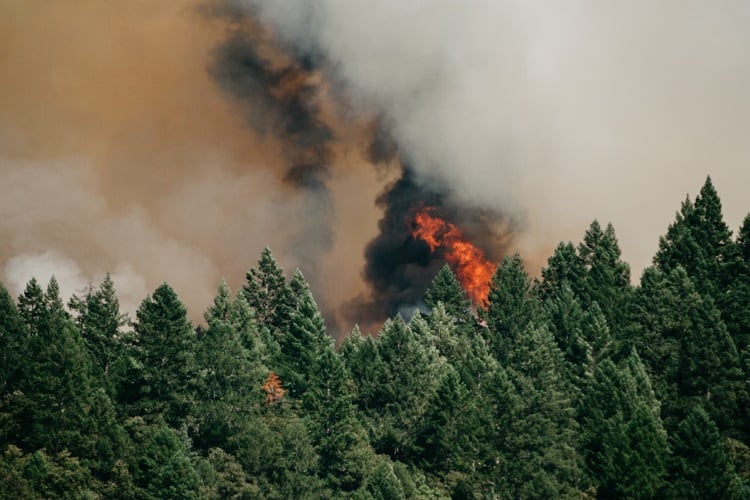
During emergencies, public safety agencies can obtain special permission to fly BVLOS (Beyond Visual Line of Sight) by obtaining a TBVLOS waiver (the T stands for Tactical).
To get a TBVLOS waiver you must have a COA—Part 107-only operators can’t apply, unfortunately.
Also, it’s important to note that you can get a TBVLOS waiver before an anticipated emergency or during an emergency, and there is a different process for each. (The process for those obtaining waivers during an emergency is accelerated to provide support as fast as possible.)
Here’s how to get a TBVLOS waiver before an emergency:
- Send your initial request to the FAA. Email your request to the FAA at 9-UAS-91.113Waivers@faa.gov.
- Submit Your COA Application for a TBVLOS 91.113(b) waiver.
Here’s how to get a TBVLOS waiver during an emergency:
- Fill out the Emergency Operations Request Form found on the FAA’s Special Governmental Interest (SGI) process page.
- Send the form to the FAA’s System Operations Support Center (SOSC) at 9-ator-hq-sosc@faa.gov.
These are just the steps at a high level. For specific step-by-step instructions, see our guide to TBVLOS waivers.
Drone As First Responder (DFR) Programs
The “Drone as First Responder” (DFR) program is a relatively new way of using drones in public safety that integrates drones into the emergency response operation of public safety agencies.
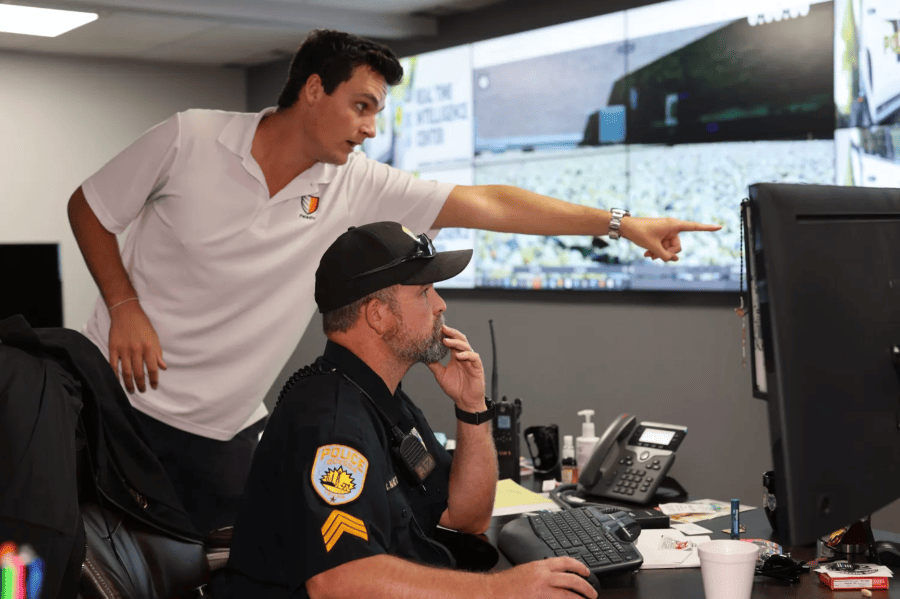
Credit: Odessa Police Department
Traditionally, first responders such as police, firefighters, and emergency medical teams are dispatched to the scene of an incident as soon as a distress call is received. In a DFR program, a drone is deployed to the scene immediately after a 911 call is received, often arriving before human responders.
The drone, equipped with high-resolution cameras and other sensors, provides real-time aerial footage and data to the emergency response teams, often while they are still en route to the incident. This live feed allows first responders to assess the situation, understand the terrain, identify potential threats, and make informed decisions before they arrive.
The DFR program not only improves the efficiency and effectiveness of emergency response operations but also enhances the safety of the first responders by providing them with critical information before they arrive on the scene. By having a clearer picture of the situation, responders can better prepare and equip themselves, ultimately leading to more successful outcomes and safer operations.
For now, the approach is used only by law enforcement, but the model could potentially be adopted by fire departments or other public safety agencies.
54 Public Safety Drone Use Cases
How exactly are public safety professionals using drones in the field?
Here’s a list of over 50 use cases for public safety drones, organized by the different types of public safety agencies that might use them.
Scroll through the list to see them all, or use the menu below to jump around.
- Public Safety Drones—Disaster Response Use Cases
- Public Safety Drones—EMT Use Cases
- Public Safety Drones—Fire Department Use Cases
- Public Safety Drones—Police Department Use Cases
- Public Safety Drones—Search and Rescue Use Cases
Public Safety Drones—Disaster Response Use Cases

Credit: DJI
1. Damage Assessment
After a natural disaster such as a hurricane, earthquake, or flood, drones can quickly assess the damage to infrastructure, buildings, and roads. They can provide real-time images and videos that help in understanding the scale of the damage and prioritizing response efforts.
2. Searching for Victims
In the aftermath of a disaster, finding and rescuing survivors is the top priority. Drones equipped with thermal cameras can locate survivors in hard-to-reach areas, at night, or under debris.
3. Delivering Emergency Supplies
Drones can be used to deliver essential supplies like food, water, and medicine to areas that are difficult to access due to damaged infrastructure or ongoing hazards.
4. Monitoring Evacuations
Drones can provide a real-time aerial view of evacuation routes and help in monitoring the movement of people and vehicles. This information is critical for managing traffic and ensuring the safety of evacuees.
5. Mapping and Situational Awareness
Drones can quickly create detailed maps of affected areas, providing emergency responders with essential information for planning and coordinating their efforts.
6. Post-disaster Infrastructure Inspection
Drones can inspect critical infrastructure such as bridges, dams, and power lines for damage that might not be visible from the ground or might be too dangerous for human inspection.
7. Hazardous Material Detection
Drones equipped with sensors can detect hazardous materials that might have been released during a disaster, helping protect first responders and the public.
8. Communication Support
In situations where communication networks are down, drones can act as temporary communication relays, helping to restore communication between emergency responders and command centers.
9. Flood Monitoring
Drones can monitor the rise of water levels in real-time and help in predicting the areas that are at risk of flooding. This information is crucial for issuing warnings to the public and planning evacuations.
10. Landslide Monitoring
Drones can monitor areas that are at risk of landslides and provide early warnings to communities and emergency responders.
11. Recovery Efforts
After the immediate emergency has passed, drones can continue to support recovery efforts by assessing the damage, supporting the rebuilding of infrastructure, and monitoring the recovery process.
Public Safety Drones—EMT Use Cases
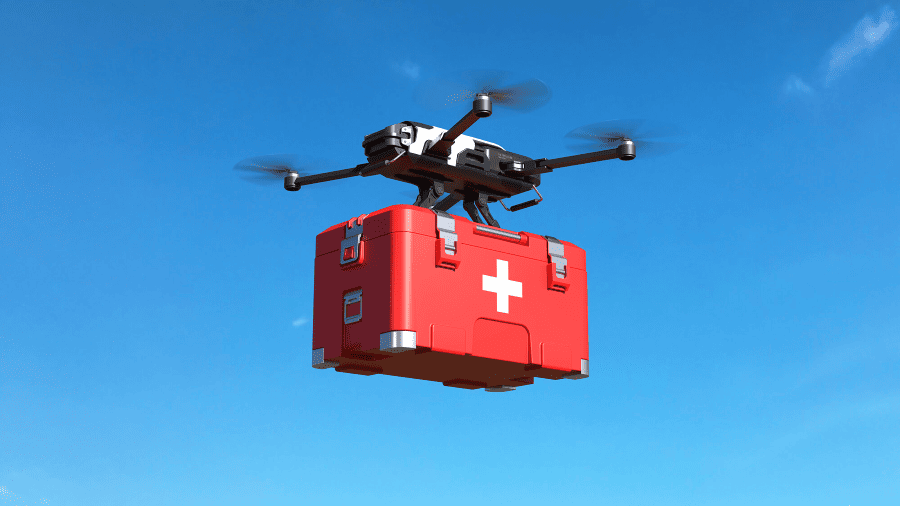
Credit: Iris Automation
12. Rapid Response
Drones can be dispatched immediately to the scene of an accident or emergency to provide real-time video feed to emergency responders. The feed can help them assess the situation and prepare necessary equipment and personnel before arriving at the scene.
13. Delivering Medical Supplies
Drones can quickly deliver essential medical supplies such as defibrillators, epinephrine, or tourniquets to remote or inaccessible areas, saving crucial time in life-threatening situations.
14. Route Planning for Ambulance Deployment
Before ambulances are dispatched, drones can be used to assess traffic conditions and find the quickest route to the emergency site, helping to reduce response times.
15. Crowd Monitoring
During large events, drones can be used to monitor crowds and identify potential medical emergencies or disturbances, enabling a quicker response from EMTs and security personnel.
16. Accident Documentation
Drones can capture aerial images and videos of accident scenes, which can be helpful for insurance purposes and for authorities to better understand the cause of accidents.
17. Hazardous Material Incidents
In situations involving hazardous materials, drones can be equipped with sensors to detect the presence of harmful substances, helping to keep EMTs and other first responders safe.
18. Remote Patient Assessment
In some cases, drones equipped with communication devices can be used to assess a patient’s condition remotely, helping to determine the level of care required before EMTs arrive on the scene.
19. Transporting Blood Samples
Drones can be used to quickly transport blood samples or other medical specimens from the emergency site to a laboratory for analysis.
20. Disaster Response
In the aftermath of natural disasters, drones can be used to assess damage, locate survivors, and deliver essential medical supplies to areas that are difficult to access by ground.
Public Safety Drones—Fire Department Use Cases
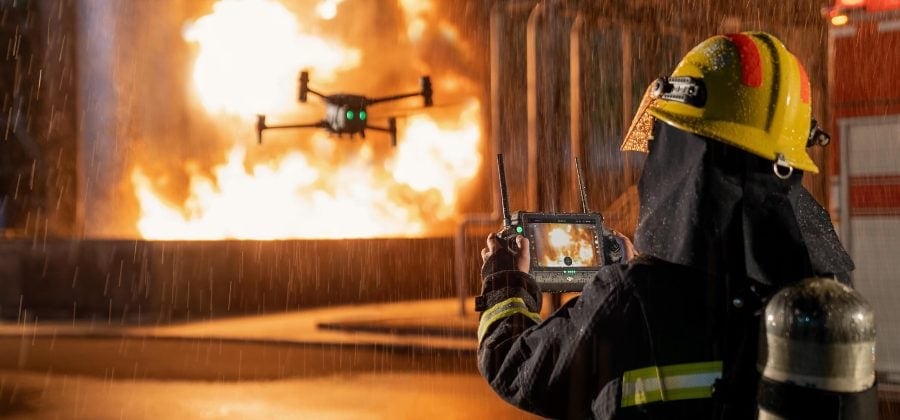
Credit: DJI
21. Assess Risk and Danger
Public safety drones support firefighting operations by providing a real-time overhead view of the fire scene, helping firefighters understand the fire’s spread and its potential path.
For structure fires, drones can reveal key information about exits and entry points and the fire’s nature. Additionally, thermal cameras attached to drones can help firefighters locate smoldering hot spots invisible to the naked eye, ensuring they are completely extinguished.
22. Respond to Disasters
Firefighters use drones to capture quick, safe information related to catastrophic events like floods, earthquakes, and hurricanes.
Early information can help incident commanders and emergency managers understand the community impact on building infrastructure, road conditions, and living conditions, aiding in determining additional resources needed from FEMA, neighboring communities, or other organizations. Drones can also help locate people trapped in homes or vehicles, diverting rescue efforts to assist them.
23. Save Lives
Using thermal cameras, firefighters can locate people trapped in a building’s upper level during a structure fire or within a wildfire, focusing their efforts on saving them. Even without thermal imagery, the ability to see into windows and gain real-time information on a burning building or wildfire situation can give firefighters crucial information to save lives.
24. Make Emergency Deliveries
Firefighters use public safety drones to make emergency deliveries in disaster situations, carrying items like Automated External Defibrillators (AEDs) and other necessary ground equipment.
25. Create Pre-Fire Plans
Firefighters use drones to capture images and create orthomosaic maps of key buildings and facilities, like schools, within their work areas. These maps help firefighters know the exits and can be used by the incident commander during a fire to compare normal and fire conditions for different building parts.
26. Arson Investigations
Drones capture aerial footage while a fire is burning, providing situational awareness and first-hand information on how the fire burned while active. This information, archived in photos and videos, can be used for investigations into the fire’s cause and progression.
After a fire burns out, drones can survey the scene and collect images turned into orthomosaic maps, serving as a complete data set for investigating the fire’s cause and progression.
27. Create Training Materials
Aerial video footage and images captured while a fire is burning are crucial in after-action assessments, where firefighters critique their efforts to improve their approach and identify future training needs. These materials can also be used to train new firefighters, providing real-life examples of how a fire might unfold and decisions made on the ground.
28. Monitoring Controlled Burns
Public safety drones equipped with thermal cameras can monitor controlled or prescribed burns to ensure the fire stays within the designated area and doesn’t pose a threat to nearby structures or wildlife.
29. Firefighting Search and Rescue Operations
Drones equipped with thermal cameras can quickly search large areas for missing persons or pets in the aftermath of a fire, especially in challenging terrains or low-visibility conditions.
30. Communication Enhancement
Drones equipped with communication devices can serve as aerial communication hubs, enhancing radio signals in areas with poor reception, ensuring clear and continuous communication among firefighting teams and command centers.
31. Aerial Firefighting
Although not widely adopted, some specialized drones can carry and drop water or fire retardant on fires in hard-to-reach areas, reducing the risk for firefighters and aiding in quickly containing the fire.
32. Hazardous Material Detection
Drones equipped with specialized sensors can detect hazardous materials at a fire scene, helping firefighters identify potential risks and take appropriate safety measures.
Public Safety Drones—Police Department Use Cases

Credit: Skydio
33. Crowd Monitoring
Public safety drones can provide real-time aerial surveillance during large public events, protests, or gatherings, helping law enforcement agencies to monitor crowd movements, identify potential threats, and deploy resources more effectively.
34. Pursuit of Suspects
Drones can aid in the pursuit of suspects by providing real-time aerial tracking, allowing ground units to better coordinate their efforts and capture suspects more efficiently while minimizing risks to the public.
35. Hostage Situations
In hostage situations, drones equipped with audio and video capabilities can provide law enforcement with valuable intelligence without risking personnel, helping in the negotiation process and planning a tactical response if necessary.
36. Crime Prevention
Public safety drones can be deployed to monitor high crime areas, providing a deterrent effect and helping in the early detection and response to criminal activities.
37. Wildlife Poaching
Drones can be used to monitor wildlife reserves and detect illegal activities such as poaching, helping law enforcement to protect endangered species and apprehend offenders.
38. Environmental Monitoring
Police drones equipped with specialized sensors can monitor environmental parameters, helping in the detection of illegal activities such as dumping of hazardous waste, and facilitating the collection of evidence for legal proceedings.
39. Surveillance of Suspected Criminal Activity
Drones can be used for the covert surveillance of suspected criminal activities, helping law enforcement agencies gather evidence without being detected.
40. Communication in Remote Areas
Public safety drones equipped with communication devices can facilitate communication in remote areas, where conventional communication systems are not available or have been compromised.
41. Delivery of Emergency Supplies
Drones can be used to deliver emergency supplies such as water, food, and medical supplies to victims of natural disasters, accidents, or other emergencies in areas that are difficult to access by foot or ground vehicle.
42. Aerial Mapping for Crime Analysis
Drones can create detailed aerial maps of crime scenes or areas of interest, providing valuable data for crime analysis and investigative purposes.
43. Traffic Monitoring
Public safety drones can monitor traffic flow and identify traffic congestion, accidents, or illegal activities such as reckless driving, helping law enforcement agencies manage traffic more effectively and ensure road safety.
44. Proactive Inspections of Critical Infrastructure
Drones can be used to inspect critical infrastructure such as bridges, dams, and power lines, helping law enforcement agencies identify potential threats and vulnerabilities and take preventive measures to ensure public safety.
Public Safety Drones—Disaster Response Use Cases
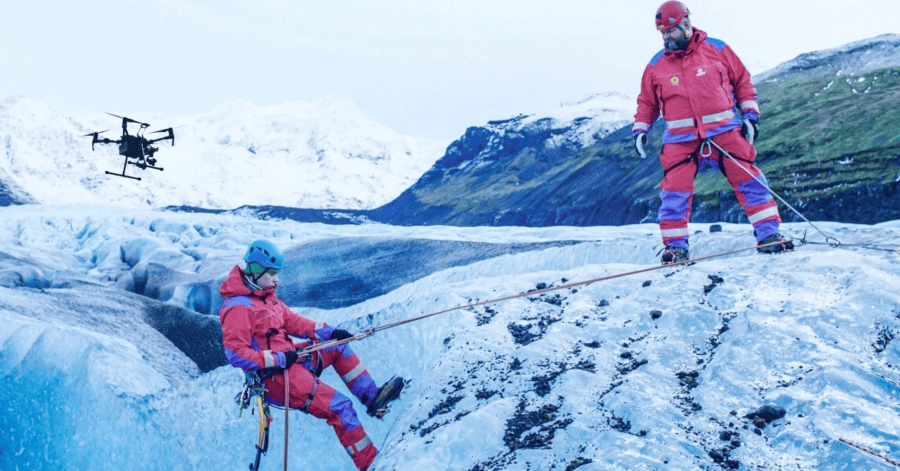
Credit: DJI
45. Locate Missing Persons
Drones equipped with thermal cameras can quickly scan large areas to locate missing persons, even in challenging environments like dense forests or at night.
46. Deliver Emergency Supplies
Drones can deliver essential supplies such as water, food, and first aid kits to stranded or injured individuals in remote or inaccessible areas until rescue teams can reach them.
47. Map Affected Areas
Drones can create real-time maps of areas where victims may be in need of help, providing search and rescue teams with up-to-date information to plan and execute their operations more effectively.
48. Monitor Natural Disasters
Drones can monitor natural disasters such as floods, landslides, and avalanches in real-time, helping search and rescue teams assess the situation and respond accordingly.
49. Assess Structural Damage
Drones can assess structural damage to buildings, bridges, and other infrastructure after natural disasters, helping search and rescue teams identify safe routes and areas to avoid.
50. Coordinate Rescue Efforts
Providing a bird’s-eye view of the rescue operation, drones can help coordinate the efforts of different teams on the ground and ensure their safety.
51. Locate Survivors in Water
Drones can fly over rivers or the ocean to locate survivors in water, helping search and rescue teams to focus their efforts and save lives.
52. Assist in Mountain Rescues
Drones can assist in mountain rescues by locating stranded or injured hikers, assessing their condition, and helping rescue teams plan their approach.
53. Support in Avalanche Rescues
Public safety drones can quickly scan avalanche areas to locate buried victims, helping rescue teams focus their efforts and save valuable time.
54. Monitor Wildlife
Drones can monitor wildlife movements in affected areas, helping search and rescue teams avoid dangerous animals and ensure their safety.


